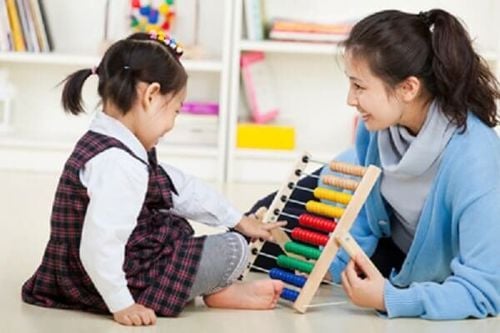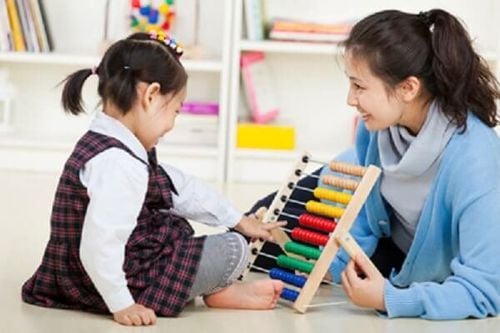This is an automatically translated article.
Article by Expert Nguyen Thi Yen - Speech therapist - Unit of Regenerative Medicine Clinic and Educational Psychology - Vinmec Times City International Hospital
Play is an important “work” that helps every child learn and grow. Through play, children can learn many skills such as: problem-solving skills, cognitive skills, language skills, thinking,... For autistic children, playing seems to be a little bit. different. Children like games that are repetitive in a structured way or focus on discovering the “details” of things, for example, watching the wheels of a car spin or lining up toys, etc. Autistic people may not be able to "play" on their own in the usual way, but need to be "taught" to play. Therefore, structured play makes a lot of sense for children with autism.
1. What is Structured Play Structured play includes structured and guided play activities by teachers, therapists, parents, or guided by setting environments (eg: visual playing process). Structured play is planned and purposeful play aimed at developing certain skills in children.
Unstructured play or free play is play led entirely by the child without adult guidance or intervention. Children play and explore play according to their interests and desires.
2. How important structured play is for children with autism Autism is a type of difficulty characterized by social impairments such as: understanding rules, game rules, division skills sharing, in turn, the ability to understand other people's feelings,... Structured play helps children:
Develop play skills and discover the right toys Know how to wait and take turns during play Increases ability ability to control one's emotions and actions Increases ability to cooperate with others during play Knows how to share toys and attention with fellow players Respond appropriately to instructions or actions of fellow players Develop social skills by imitating the actions of the player as well as the thoughts and feelings of other players.

Chơi có cấu trúc quan trọng với trẻ em tự kỷ
3. Instruct a child with autism in structured play Start with an activity/toy that your child enjoys. For example, children love to play with cars, you can organize car jigsaw or car coloring activities,... Use your child's strengths. For example: children love to be active or can sit for hours,... Use a visual schedule for play activities to clearly show children: how much play action is involved in this activity, actions What to do first, what to do later. Each action/step should be clearly and specifically illustrated with objects, pictures, and words. Guide your child to use a step-by-step schedule of play activities, making sure they understand how to do it before letting them play on their own or increasing activities during their playtime. While designing activity schedules and play instructions, make sure that your instructions are clear but concise and appropriate for your child's understanding. When starting to play structured, you should choose activities that are short, moderate, ensuring children can succeed from the first play. This helps increase children's interest and motivation to play. Organize short play activities instead of multi-step activities; or children only need to participate in certain play steps, not participating in the entire play process. The gradual participation of children will help children not to be overloaded as well as help children's attention span gradually increase. Praise, encourage, and acknowledge all of your child's efforts during play.
4. Develop Children's Play Skills Once children are used to and able to complete a structured play activity on their own, you can:
Increase the number of play actions, extend the consequences of the game. Increase the number of games/activities your child needs to do Increase the number of opportunities your child can play each day.

Hướng dẫn trẻ tự kỷ chơi có cấu trúc
5. Parenting Strategies Wait for your child to initiate, observe how they play, listen to what they have to say, and respond in a meaningful way. Use the level of support appropriate to the child's ability. For example, if the child can do it himself, you just need to wait and prompt with natural prompts such as: arrange learning materials; If it's a new play activity, you can model or hand it to your child. Create opportunities for children to actively express and initiate play activities they want. Controls the environment but does not interfere or alter the game structure. Use an activity schedule that is flexible to your child's abilities. The most important thing about playing is the fun and excitement, the desire to play, to discover the game. Therefore, while organizing play activities, you should be flexible and sensitive to children's "discomfort" signs to promptly adjust play activities accordingly.
Clinic and educational psychology unit of Vinmec Times City Hospital's Regenerative Medicine Center is a pioneer in applying scientific and artistic methods to assess and treat children with autism, bringing effective results. high.
Areas of educational intervention for children with autism at Vinmec: Clinical psychology - educational psychology; Special Education; Speech therapy; Meditation – therapeutic yoga; Music therapy; Art therapy
The team of doctors, therapists and teachers at the Center are trained at prestigious schools: University of Education, University of Social and Human Sciences - Hanoi National University, Academy of Sciences education management... and regularly learn to improve skills through short-term and long-term training courses at home and abroad with leading experts from the US, Australia, India, Italy.
Please dial HOTLINE for more information or register for an appointment HERE. Download MyVinmec app to make appointments faster and to manage your bookings easily.













